Solana is a cryptocurrency that was launched in April 2020, that is, relatively recently. Its popularity has exploded recently as its price has grown exponentially in recent months.
In January its value was established at 1.5 dollars, and at the time of writing this article it has a price of 199.65 dollars. However, it reached a market value of $208 in early September.
These figures make it the sixth-largest coin in the world with a market capitalization of 61 billion.
In this article, we are going to discover everything we need to know about Solana SOL, and thus we can discover if this notable price increase is justified.
Table of Contents
What is Solana (SOL)?
Solana is a blockchain platform for decentralized applications. The project is open-source maintained by the Geneva-based Solana Foundation and built by developers from San Francisco-based Solana Labs.
Solana is the direct competition of the famous Ethereum chain network, which is currently the largest decentralized application platform. However, Solana promises faster operation and lower transaction fees.
It is a proof-of-stake (PoS) -based blockchain, making it a greener network than PoW (proof-of-work) blockchains like Bitcoin. Its native cryptocurrency is also called Solana and has the symbol SOL.
What’s good about PoS?
In a decentralized blockchain system, many computers known as nodes validate transactions. To protect this network, a mathematical puzzle is introduced into the algorithm that makes an attack on the network more difficult. This would be the definition of PoW or proof of work, an effective form of protection but which ends up consuming a lot of energy.
Another way to protect the nodes of the network is by making the validators have to bet something, and for this, the SOL tokens are used. This would be the PoS or proof of stake system, and although the validators of the Solana network also consume energy to operate, their energy use is much lower than that of the miners of, for example, Bitcoin.
Both the PoW and PoS mechanisms reward validators or miners for their efforts; Bitcoin miners get BTC, and at Solana, validators are rewarded with SOL. It’s worth noting that in Solana, end-users don’t have to run a validation node to earn rewards; they can delegate their participation to a validator who will pass the rewards to them for a fee.
Solana’s story
The Solana (SOL) platform was founded in 2017 by Anatoly Yakovenjo. Yakovenko worked at Qualcomm before founding Solana. He has extensive experience with comprehension algorithms after his previous experience at Dropbox as a software engineer. Along with Eric Williams and Solana’s CTO. Greg Fitzgerald created a new process to deal with the traditional performance issues that existed in the Bitcoin and Ethereum blockchains.
They hoped to create a trustless, distributed protocol that would allow for greater scalability. Today, the team is backed by the experiences of the world’s leading organizations, including Apple, Qualcomm, Intel, Google, Microsoft, Twitter, Dropbox and more. Solana’s impact also attracted the attention of many investors such as Multicoin Capital, Foundation Capital, SLOW Capital, CMCC Global, Abstract Ventures and more.
Why is Solana better than other cryptocurrencies and blockchains?
All of the above sounds a lot like Ethereum, and in fact, Solana is more easily described as an advanced competitor to Ethereum. There are many more applications on Ethereum. Why change?
Ethereum has long been plagued by high transition fees that sometimes skyrocket to hundreds or even thousands of dollars, especially during times of high network congestion. Solana has a higher theoretical throughput, which means that it can handle more transactions per second than Ethereum, so the fees are currently very low.
In practice, once you have a wallet that can contain Solana-based tokens (SOL), such as Phantom or Sollet, you can interact with the many applications it contains.
You can exchange one token for another on any exchange such as Raydium or Binance, or you can buy an NFT on the Solanart market.
Why is Solana (SOL) rising?
Solana’s price hike has been staggering. Someone who participated in the Solana ICO (initial coin offering, a way to finance a project by selling tokens) was able to buy SOL for $0.22. The price rose to 208, which is an increase of 95,000%.
To be fair, other promising Ethereum competitors, including Cardano, Polkado, Dfinity, Terra, Polygon, and Avalanche, have also surged in price tremendously over the year. But Solana’s rise has been special.
One reason for the growth is the fact that Solana is backed by the popular coin exchange FTX, which has launched several Solana-based projects. Alameda Research, the same firm that backs FTX, is one of the largest investors in Solana, along with Andressen Horowitz and Polychain.
Another reason is the transaction fees, which are lower than most of the competitors.
Then there is the TVL (total locked value), a metric that counts how much value has been locked into projects in the Solana ecosystem. According to DefiLlama, a website that tracks decentralized financial projects, Solana is currently the third-largest network in terms of TVL, with a total of 7.9 billion blocked on projects on its networks.
Will Solana’s rise continue?
Solana is just one competitor in a world of decentralized application platforms, each with its strengths and weaknesses. It shows great promise, has a flourishing app ecosystem, and continued support from FTX and some of the biggest venture capitalists in the space. It has a long way to go to catch up with Ethereum, but it is well-positioned to get a decent share of the decentralized app market. Anyone interested in decentralized applications and the Blockchain space should at least dip their toes and give Solana a try.
Probably wanna read:

